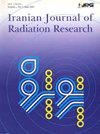Patient radiation dosimetry during interventional cardiac procedures
Q4 Health Professions
引用次数: 4
Abstract
Background: Cardiac catheterization plays an essential role in the evaluation of suspected heart failure patients. This work aimed to determine the mean effective dose of patients undergoing catheterization tests and to estimate the associated radiation risk of malignancy. Material and Methods: Measurements were performed during 65 coronary angiographies (CA), 70 coronary angioplasties (PTCA) 27, radio fluoroscopy (RF) ablations and 25 electro physiologies procedures in a dedicated laboratory. The procedures were undertaken with the Siemens and General Electric X-ray equipment. A dose area product (DAP) meter was also used. The DAP values and fluoroscopy times were recorded for each patient. Results: The mean DAP values and patient effective doses were 19.53 Gy.cm and 1.71 mSv for CA, 49.74 Gy.cm2 and 4.57 mSv for PTCA, 153.34 Gy.cm and 16.38 mSv for ablations and 14.88 Gy.cm and 1.65 mSv for electrophysiology, respectively. The patient radiation risk was estimated at 13, 1.3, 1.3, 3.6 fatal cancer per 10000 procedures of ablations, electrophysiology, CA and PTCA cases, respectively. Conclusion: Results showed that the radiation risk due to RF cardiac ablation is higher than the other complication procedures so, efforts should be made to minimize patient radiation risk from RF ablation procedures. Also we found no clear correlation between cardiologist level of experience and reduced level of patient’s dose.心脏介入手术中的患者辐射剂量测定
背景:心导管插入术在评估疑似心力衰竭患者中起着至关重要的作用。这项工作旨在确定接受导管插入术检查的患者的平均有效剂量,并估计恶性肿瘤的相关辐射风险。材料和方法:在一个专门的实验室中,在65次冠状动脉造影(CA)、70次冠状动脉血管成形术(PTCA)27、射频透视(RF)消融和25次电生理过程中进行测量。这些程序是用西门子和通用电气的X射线设备进行的。还使用了剂量-面积乘积(DAP)计。记录每位患者的DAP值和荧光镜检查时间。结果:CA的DAP平均值和患者有效剂量分别为19.53 Gy.cm和1.71 mSv,PTCA为49.74 Gy.cm2和4.57 mSv,消融为153.34 Gy.cm或16.38 mSv,电生理为14.88 Gy.cm及1.65 mSv。据估计,每10000例消融、电生理、CA和PTCA病例中,患者的辐射风险分别为13、1.3、1.3、3.6致命癌症。结论:结果表明,射频心脏消融术的辐射风险高于其他并发症,因此应努力将射频消融术对患者的辐射风险降至最低。此外,我们还发现心脏病专家的经验水平和患者剂量水平的降低之间没有明确的相关性。
本文章由计算机程序翻译,如有差异,请以英文原文为准。
求助全文
约1分钟内获得全文
求助全文
来源期刊

Iranian Journal of Radiation Research
RADIOLOGY, NUCLEAR MEDICINE & MEDICAL IMAGING-
CiteScore
0.67
自引率
0.00%
发文量
0
审稿时长
>12 weeks
期刊介绍:
Iranian Journal of Radiation Research (IJRR) publishes original scientific research and clinical investigations related to radiation oncology, radiation biology, and Medical and health physics. The clinical studies submitted for publication include experimental studies of combined modality treatment, especially chemoradiotherapy approaches, and relevant innovations in hyperthermia, brachytherapy, high LET irradiation, nuclear medicine, dosimetry, tumor imaging, radiation treatment planning, radiosensitizers, and radioprotectors. All manuscripts must pass stringent peer-review and only papers that are rated of high scientific quality are accepted.
 求助内容:
求助内容: 应助结果提醒方式:
应助结果提醒方式:


